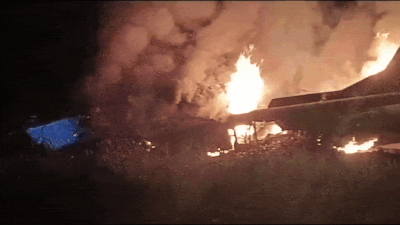Indian Air Force MiG-29 Crashes During Night Training in Rajasthan; Pilot Safely Ejects

In a dramatic incident that underscores the risks associated with military aviation, an Indian Air Force (IAF) MiG-29 fighter jet crashed near Barmer, Rajasthan, on a recent Monday night. The crash occurred during a routine night training mission, highlighting the ever-present dangers faced by pilots even in non-combat scenarios. Fortunately, the pilot managed to eject safely, and no casualties or damage to civilian property were reported.
The MiG-29, a workhorse of the IAF’s fighter fleet, encountered a critical technical defect mid-flight, which forced the pilot to make the split-second decision to eject. The IAF has since announced that a Court of Inquiry will investigate the incident to determine the exact cause of the malfunction. This crash is a stark reminder of the aging fleet's challenges, as the MiG-29s have been in service with the IAF since the 1980s, originally designed to counter the U.S. F-15s and F-16s during the Cold War era.
Rajasthan's Barmer district, where the crash took place, has seen its share of military activity due to its proximity to the western border. Barmer collector Nishant Jain, along with Superintendent of Police Narendra Meena and other senior officials, quickly reached the crash site. According to Meena, the crash occurred away from populated areas, which likely prevented further casualties. However, the site presented its own challenges—heavy rain had left the area waterlogged, complicating efforts by the fire brigade and emergency responders to reach and secure the crash site. The wreckage of the jet continued to burn, necessitating a cautious approach as per the Air Force’s Standard Operating Procedures (SOPs).
Local villagers also played a role in the immediate aftermath, coming forward to assist officials in ensuring safety and providing necessary support. The pilot's survival is a testament to the reliability of the aircraft's ejection system, which is designed to function even under extreme conditions.
This incident follows another recent crash involving an IAF aircraft. On June 4, a Sukhoi Su-30MKI fighter jet crashed near Shirasgaon village in Maharashtra’s Nashik district. Similar to the Barmer incident, the pilots in that crash also managed to eject safely, though they sustained minor injuries and were treated at a nearby hospital.
The IAF operates a fleet of MiG-29s that have been periodically upgraded to keep them combat-ready. However, as these jets age, incidents like the one in Barmer raise questions about the operational lifespan of these aircraft and the importance of timely upgrades and replacements to ensure pilot safety and mission success.
As the investigation into the Barmer crash unfolds, it will likely prompt further discussions on the modernization of the IAF’s fleet, the need for advanced training protocols, and the balance between maintaining legacy aircraft and introducing newer, more reliable platforms into service. The pilot's safe ejection, while a relief, also serves as a stark reminder of the high stakes involved in every flight.


